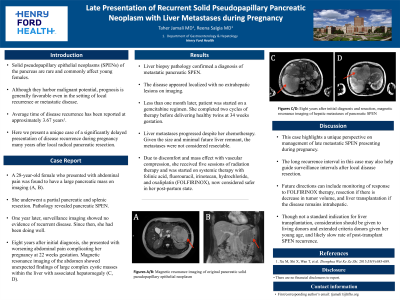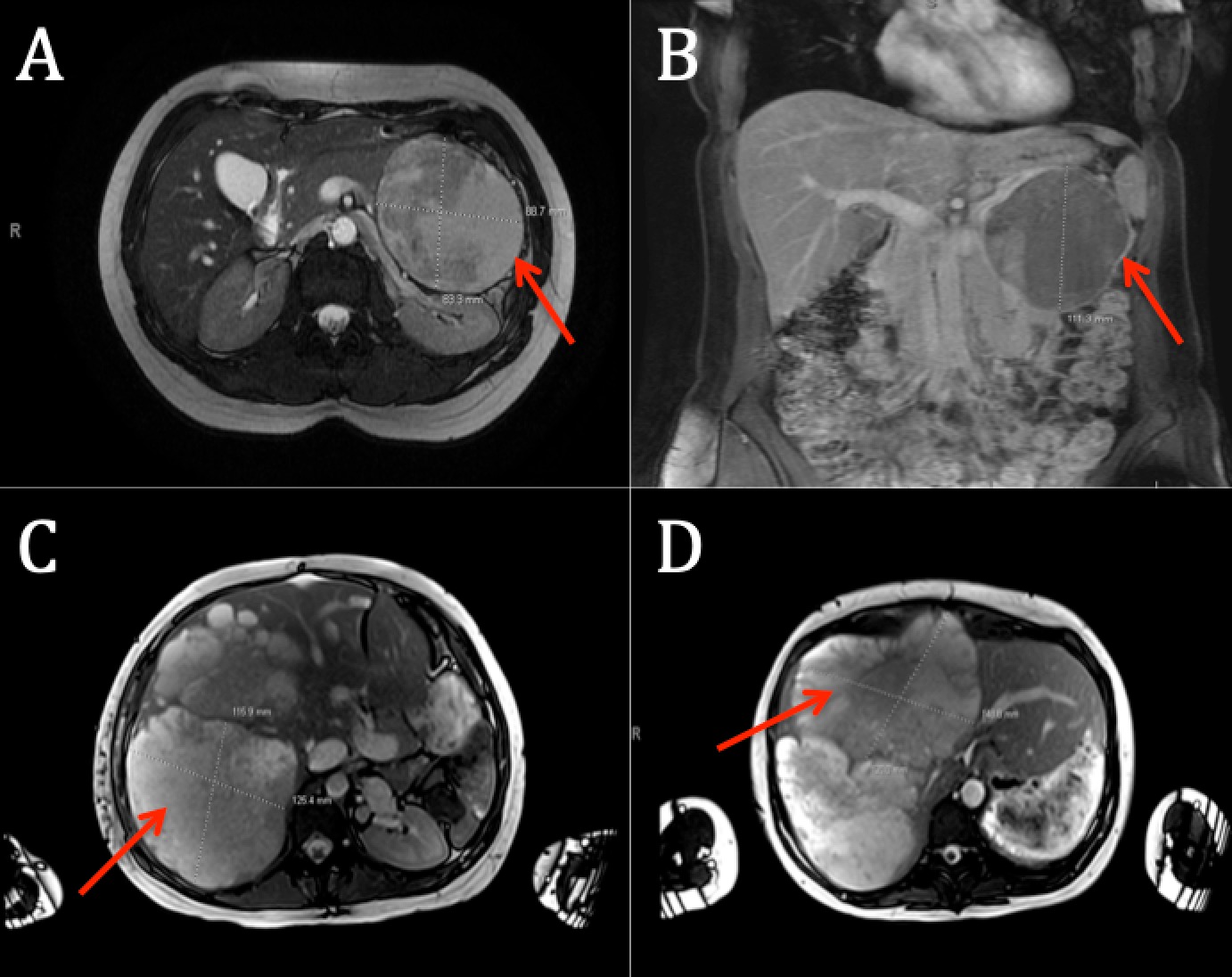Sunday Poster Session
Category: Liver
P1043 - Late Presentation of Recurrent Solid Pseudopapillary Pancreatic Neoplasm With Liver Metastasis During Pregnancy
Sunday, October 22, 2023
3:30 PM - 7:00 PM PT
Location: Exhibit Hall

Has Audio

Taher Jamali, MD
Henry Ford Health
Farmington Hills, MI
Presenting Author(s)
Taher Jamali, MD1, Reena Salgia, MD2
1Henry Ford Health, Farmington Hills, MI; 2Henry Ford Health, Detroit, MI
Introduction: Solid pseudopapillary epithelial neoplasms (SPENs) of the pancreas are rare and commonly affect young females. Prognosis is generally favorable even in the setting of local recurrence or metastatic disease. Average time of disease recurrence after resection has been reported around 3.67 years1. Here we present a unique case of delayed presentation of disease recurrence during pregnancy many years after local radical pancreatic resection.
Case Description/Methods: A 28-year-old female who presented with abdominal pain was found to have a large pancreatic mass on imaging (1A, 1B). She underwent a partial pancreatic and splenic resection. Pathology revealed pancreatic SPEN. One year later, surveillance imaging showed no evidence of recurrent disease. Since then, she had been doing well. Eight years after initial diagnosis, she presented with worsening abdominal pain complicating her pregnancy at 22 weeks gestation. Magnetic resonance imaging of the abdomen showed unexpected findings of large complex cystic masses within the liver with associated hepatomegaly (1C, 1D). Liver biopsy pathology confirmed a diagnosis of metastatic pancreatic SPEN. The disease appeared localized with no extrahepatic lesions on imaging. Less than one month later, patient was started on a gemcitabine regimen. She completed two cycles of therapy before delivering healthy twins at 34 weeks gestation. Liver metastases progressed despite her chemotherapy. Given the size and minimal future liver remnant, the metastases were not considered resectable. Due to discomfort and mass effect with vascular compression, she received five sessions of radiation therapy and was started on systemic therapy with folinic acid, fluorouracil, irinotecan, hydrochloride, and oxaliplatin (FOLFIRINOX), now considered safer in her post-partum state.
Discussion: This case highlights a unique perspective on management of late metastatic SPEN presenting during pregnancy. The long recurrence interval in this case may also help guide surveillance intervals after local disease resection. Future directions can include monitoring of response to FOLFIRINOX therapy, resection if there is decrease in tumor volume, and liver transplantation if the disease remains intrahepatic. Though not a standard indication for liver transplantation, consideration should be given to living donors and extended criteria donors given her young age, and likely slow rate of post-transplant SPEN recurrence.
1. Xu M, Shi X, Wan T, et al. Zhonghua Wai Ke Za Zhi. 2015;53(9):685-689.

Disclosures:
Taher Jamali, MD1, Reena Salgia, MD2. P1043 - Late Presentation of Recurrent Solid Pseudopapillary Pancreatic Neoplasm With Liver Metastasis During Pregnancy, ACG 2023 Annual Scientific Meeting Abstracts. Vancouver, BC, Canada: American College of Gastroenterology.
1Henry Ford Health, Farmington Hills, MI; 2Henry Ford Health, Detroit, MI
Introduction: Solid pseudopapillary epithelial neoplasms (SPENs) of the pancreas are rare and commonly affect young females. Prognosis is generally favorable even in the setting of local recurrence or metastatic disease. Average time of disease recurrence after resection has been reported around 3.67 years1. Here we present a unique case of delayed presentation of disease recurrence during pregnancy many years after local radical pancreatic resection.
Case Description/Methods: A 28-year-old female who presented with abdominal pain was found to have a large pancreatic mass on imaging (1A, 1B). She underwent a partial pancreatic and splenic resection. Pathology revealed pancreatic SPEN. One year later, surveillance imaging showed no evidence of recurrent disease. Since then, she had been doing well. Eight years after initial diagnosis, she presented with worsening abdominal pain complicating her pregnancy at 22 weeks gestation. Magnetic resonance imaging of the abdomen showed unexpected findings of large complex cystic masses within the liver with associated hepatomegaly (1C, 1D). Liver biopsy pathology confirmed a diagnosis of metastatic pancreatic SPEN. The disease appeared localized with no extrahepatic lesions on imaging. Less than one month later, patient was started on a gemcitabine regimen. She completed two cycles of therapy before delivering healthy twins at 34 weeks gestation. Liver metastases progressed despite her chemotherapy. Given the size and minimal future liver remnant, the metastases were not considered resectable. Due to discomfort and mass effect with vascular compression, she received five sessions of radiation therapy and was started on systemic therapy with folinic acid, fluorouracil, irinotecan, hydrochloride, and oxaliplatin (FOLFIRINOX), now considered safer in her post-partum state.
Discussion: This case highlights a unique perspective on management of late metastatic SPEN presenting during pregnancy. The long recurrence interval in this case may also help guide surveillance intervals after local disease resection. Future directions can include monitoring of response to FOLFIRINOX therapy, resection if there is decrease in tumor volume, and liver transplantation if the disease remains intrahepatic. Though not a standard indication for liver transplantation, consideration should be given to living donors and extended criteria donors given her young age, and likely slow rate of post-transplant SPEN recurrence.
1. Xu M, Shi X, Wan T, et al. Zhonghua Wai Ke Za Zhi. 2015;53(9):685-689.

Figure: Figure1: A/B) Magnetic resonance imaging of original pancreatic solid pseudopapillary epithelial neoplasm (SPEN); C/D) Eight years after initial diagnosis and resection, magnetic resonance imaging of hepatic metastases of pancreatic SPEN
Disclosures:
Taher Jamali indicated no relevant financial relationships.
Reena Salgia indicated no relevant financial relationships.
Taher Jamali, MD1, Reena Salgia, MD2. P1043 - Late Presentation of Recurrent Solid Pseudopapillary Pancreatic Neoplasm With Liver Metastasis During Pregnancy, ACG 2023 Annual Scientific Meeting Abstracts. Vancouver, BC, Canada: American College of Gastroenterology.
